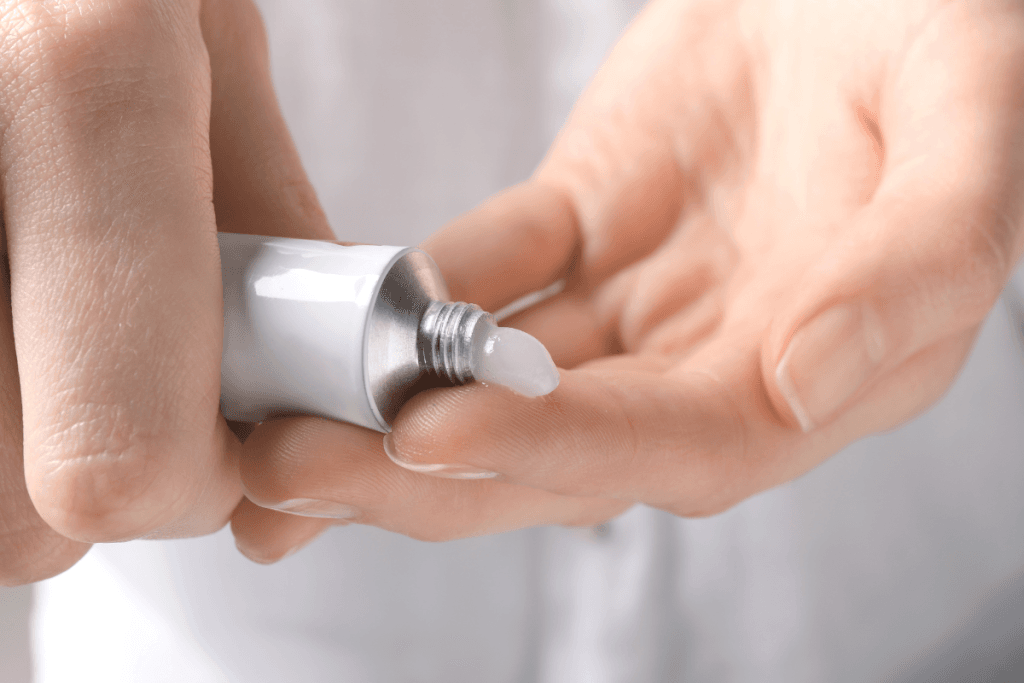Topical anesthetics (skin-numbing medicines) can reduce needle-procedure discomfort and improve workflow. In many outpatient settings, EMLA Cream is the name clinicians recognize most. It is often discussed alongside injectables, laser prep, and other minor in-office procedures. For clinic teams, the practical questions are predictable. What is it, where does it fit, how long should you plan, and what should you document?
This guide focuses on clinic-facing use and operations. It summarizes what the lidocaine/prilocaine combination is, how it works at a high level, and where labeling boundaries matter. It also covers common “over the counter” questions, safety considerations, and procurement checks. For topical options and adjacent products, many practices browse a hub like Creams And Serums to standardize what staff can select.
Key Takeaways
- Two-actives cream used for superficial dermal anesthesia
- Timing depends on site, occlusion, and procedure plan
- Screen for contraindications and methemoglobinemia risk factors
- Clarify Rx status, substitution rules, and documentation needs
EMLA Cream In Clinic Practice: Where It Fits
EMLA is a topical local anesthetic cream that combines two amide anesthetics, lidocaine and prilocaine. Clinically, it is used to create dermal analgesia (reduced skin pain) for certain superficial procedures. In day-to-day operations, it is most often considered when you want a predictable numbing option without an injection at the site.
Common clinic drivers are patient comfort, reduced startle during needle entry, and smoother throughput for planned minor procedures. That said, topical anesthesia is never “set-and-forget.” It adds scheduling steps, staff time, and a safety screen. You also need clear internal policies about who applies it, where it may be applied, and how staff confirms contraindications.
Why it matters: Topical anesthesia affects scheduling, consent language, and safety checks, not just comfort.
Access is limited to verified licensed clinical purchasers.
Composition And Mechanism
Some clinicians call this an “EMLA 5 cream” because the combined anesthetic content totals 5% (2.5% lidocaine plus 2.5% prilocaine). It is sometimes referenced as the lidocaine/prilocaine cream brand name in workflows, even when the clinic stocks a generic equivalent. Mechanistically, both actives reversibly block sodium channels in peripheral nerves. That reduces nerve signal transmission from superficial tissues. The eutectic mixture (a formulation that keeps both actives in an oil phase) helps penetration through the stratum corneum, especially when used with occlusion.
Operationally, the mechanism matters because effect depends on contact time, skin thickness, and whether the area is intact or inflamed. It also matters because systemic absorption can increase when applied over large areas, under occlusion for long periods, or on compromised skin. Those factors should be built into your standard operating steps and staff education.
Indications, Off-Label Queries, And Boundary Setting
Because patients search broadly for “numbing cream,” clinic teams often get questions that mix labeled indications with off-label ideas. These include what is lidocaine and prilocaine cream used for, and whether it can help with itching, hemorrhoids, or muscle pain. These questions tend to surface before injections, cosmetic procedures, and sensitive-site care planning.
In many practices, the safest operational approach is to anchor staff messaging in labeling and local protocols. Use your intake and procedure notes to document why topical anesthesia is being considered, the planned site, and what screening occurred. When a request falls outside routine use, treat it as a clinician decision rather than a front-desk or MA “yes/no.”
What People Mean By “Numbing Cream”
Patients and even staff may use one phrase for different products. A patient asking about “prilocaine cream over the counter” may actually mean any topical anesthetic that reduces skin sensation. In the U.S., many anesthetic combinations with prilocaine are prescription products, while other topical anesthetics may be available nonprescription with different actives and labeling. This is one reason to avoid informal substitution. If your clinic is standardizing inventory, keep a short reference list that includes the generic name, the intended procedure types, and any site restrictions.
For teams that want consistent product selection, it can help to keep topical options grouped in one internal list and cross-reference your supplier’s category structure, such as Topical Creams Category, to reduce “look-alike” picking errors.
Timing And Duration: Planning The Patient Flow
Topical anesthesia has a planning cost. The effect is not immediate, and the “how long to work” expectation varies by site and technique. For intact skin, labeling for lidocaine/prilocaine combinations typically describes application times on the order of about an hour, often with occlusion, to achieve adequate dermal anesthesia. For certain mucosal uses, labeling may describe shorter application windows. Your team should rely on the specific product’s official instructions rather than memory.
In practice, staff questions also include emla cream how long does it last. Duration is influenced by the same variables that affect onset: dose area, occlusion, skin thickness, temperature, and local perfusion. Your scheduling template should assume variability. Build buffer time for first-time patients, anxious patients, and complex procedure rooms.
Quick tip: Add a scheduling note field for “topical anesthetic applied time.”
Occlusion, Dressing, And “Without Dressing” Situations
Clinics commonly use occlusive dressings to keep the cream in place and improve penetration. When teams ask how to use emla cream without dressing, it is often a workflow issue: limited dressing supply, awkward anatomic site, or concern about mess. Operationally, “no dressing” can increase variability and accidental transfer to clothing or staff gloves. If you anticipate dressing challenges, plan alternate containment methods permitted by your protocol (for example, pre-cut occlusive materials for common procedure sites) and ensure PPE and surface cleaning steps are clear.
Also plan who removes the cream, how the area is cleaned, and how you prevent spread to unintended sites. These steps reduce the chance of ocular exposure or contact with mucous membranes when that is not intended. Use consistent documentation language so the chart reflects timing and handling.
Checklist: Procedure-Day Setup For Topical Anesthesia
- Confirm product identity + expiration
- Verify planned site is appropriate
- Screen allergy and risk factors
- Document application start time
- Use occlusion per protocol
- Remove and cleanse area consistently
- Record any skin reactions observed
For procedure contexts that often involve topical prep, your staff may also benefit from cross-training with related service lines. For example, anesthesia timing can affect room turnover for Mesotherapy Injections Overview and other injection-based protocols.
Safety Profile, Contraindications, And Side Effects To Watch
Like other local anesthetics, lidocaine/prilocaine creams can cause localized reactions. These may include transient blanching or redness, edema, or burning sensations at the application site. More serious events are uncommon but clinically important for policy design. Prilocaine, in particular, is associated with methemoglobinemia (a condition where hemoglobin carries oxygen less effectively). The risk rises in susceptible patients and with higher exposure conditions.
When teams review emla cream side effects, keep the discussion tied to your screening workflow. Document known hypersensitivity to amide anesthetics. Confirm whether the patient has conditions or concomitant medicines that may increase methemoglobinemia risk (for example, certain oxidizing agents). Also document whether the intended site is intact skin versus compromised skin, because absorption can differ.
Products are brand-name items supported by distributor traceability documents.
Contraindications and warnings are product-specific, so avoid assuming interchangeability across topical anesthetics. This matters when clinics are asked about “over the counter” alternatives. A patient may assume a nonprescription lidocaine product is “basically the same,” but labeling, concentration, and intended use can differ. If your team fields questions like emla cream contraindications, the correct operational step is to refer to the official labeling and your clinician-approved screening questions.
Common Pitfalls That Create Avoidable Risk
- Large-area application without escalation path
- Unclear responsibility for removal and cleansing
- Inadequate documentation of timing and site
- Assuming OTC equals safer for all
- Using on compromised skin without review
For aesthetic practices that combine topical prep with peel or resurfacing workflows, standardization matters. If your protocols overlap with chemical peel pathways, align your prep steps with clinical education like the PRX-T33 Treatment Guide so staff do not mix steps across service lines.
Procurement, Verification, And Clinic Documentation
Supply chain controls are part of clinical quality. Stock topical anesthetics the same way you stock injectables: verify product identity, maintain traceability, and keep receiving records. If your team is evaluating EMLA Cream in a procurement meeting, focus on documentation readiness and standard work, not just preference. Confirm whether your facility policies require recording lot numbers in the chart for in-office application, and whether that differs by procedure type.
For clinics using MedWholesaleSupplies, the service model is oriented to licensed healthcare professionals and practice purchasing workflows. The catalog reference for this product can be found under EMLA Product Listing. If you are consolidating topical items, you can also keep a standardized shortlist in your formulary tied to the Creams And Serums category structure.
Supply chains rely on screened distribution partners rather than informal marketplaces.
Clinic Workflow Snapshot (High Level)
Keep the workflow simple and auditable. First, verify the product on receipt and record the lot and expiration per your policy. Next, document storage location and who has access. Then, during the visit, confirm indication, site, and screening items in the note. Apply and remove per protocol, and record observed reactions. Finally, record any incident reports and restock actions so trends can be reviewed in quality meetings.
If your practice spans medical and aesthetic services, try to harmonize documentation language across departments. A shared template helps when patients move between treatment types, such as those covered in Anti-Aging Treatments Overview and injectable skin support discussions like Fillmed NCTF 135 HA.
For logistics planning, many clinics prefer suppliers with US distribution to reduce variability in receiving. Confirm storage requirements from labeling, and align them with your inventory controls. Packaging sizes can vary by manufacturer and market, so if staff search emla cream 30g, treat that as a procurement detail to verify on the product listing and invoice, not an assumed standard size.
Authoritative Sources
- For official labeling and warnings, consult DailyMed labeling search results.
- For general topical lidocaine safety information, see MedlinePlus: lidocaine topical.
In most clinics, success with topical anesthesia is operational. Standardize product selection, screen consistently, and document timing every time. When patient questions arise about emla cream over the counter or substitutions, anchor responses in labeling and your protocols rather than assumptions. If you are coordinating multi-site care, note that inventory sourcing and receiving processes may differ even when products are shipped from the US.
This content is for informational purposes only and is not a substitute for professional medical advice.







